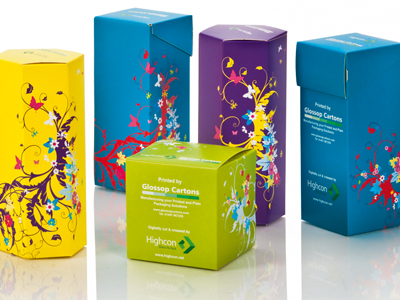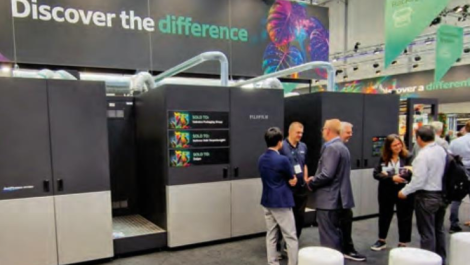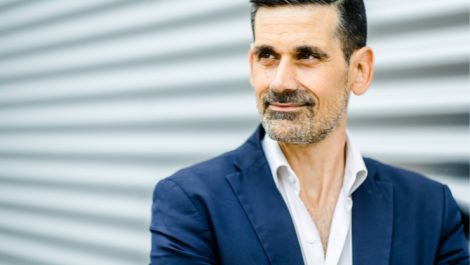Whilst digital technology is still low man on the totem pole in the packaging print hierarchy in terms of outputted volume, in the right hands it can deliver a crucial point of difference way beyond the capability of its analogue competition. Leading adopters from four key sectors explain to Des King how they’re matching marketing aspiration with digital versatility.
Jacky Sidebottom-Every, sales director, Glossop Cartons

Nick Kirby, managing director, Swanline Print

Adrian Steele, managing director, Mercian Labels

Chris Tonge, sales & marketing director, Ultimate Packaging

Company details and digital equipment
Est. 1982, turnover £5.2m
Acuity LED wide format printer, Highcon Euclid cutting and creasing
Est 2001, turnover £10.6m
Two HP Scitex FB10000 presses
Est 1969, turnover £3.5m
Xeikon 3300 and Xeikon Cheetah presses
Est 1982, turnover £45m
HP Indigo WS6600 and HP Indigo 20000 presses
Why did you invest in digital printing technology?
We recognised the need as a company to be inventive, innovative and most of all different from our competitors and stand out from the crowd. When the opportunity came along to buy both our digital machines and we saw each being demonstrated, we knew how they would form an integral part of our carton production with the ability to offer clients new and exciting packaging concepts.
As an alternative to screen and offset litho to fulfil a competitive solution for an increasing trend and demand towards shorter run lengths, without origination costs; to provide competitive solutions for versioning, regionalised and personalised packaging; to improve speed to market capability; and to improve in house margin.
Digital offers attractive benefits to our customer-base that help to strengthen our relationship; for example, much quicker lead times which is a very strong driver from the market place. It also enables us to cut the cost down and create a whole brand new market for a high amount of versioning; it’s a profile of business that’s just not viable in conventional analog printing (typically flexo).
Customer demands for short print runs, on-demand print runs and the need for greater creativity for brand marketing campaigns that feature a more social aspect and link to ecommerce and social media.
The business is now working with major brands on projects that feature limited edition personalised, customised and multi-SKU runs.
What is the proportion of current turnover accounted for by digital and how much will it be in 2020?
10% – We predict that this will be in the range of 30% along with solid growth of turnover in 2020
21% – I expect it to be around 50% in 2020
70% – We see the technologies as being complementary, and increasingly so. I could actually see the current 70% proportion coming down, even though digital volumes are still rising in line with the company’s upward expansion.
1% – My prediction is 10% of our overall flexible business in the UK by 2020 (excluding Sharp Iris activity).
How much of turnover is new business and how is much existing business that has switched to digital?
80% new business / 20% switched across.
13% new / 8% switched across
Very difficult to accurately assess. Apart from a few very well informed customers, most are less interested in whether the job is printed digital or analogue than how much is it going to cost and how quickly can they have it.
Mainly new business, but with the installation of the wider format press a number of customers are now placing digital print orders along with conventional.
What are your future plans for investment?
We are still looking for a viable digital press that will deliver a cost-effective manufacturing print process to our company that not only equals the quality of conventionally printed packaging, but also shows a saving on small runs. When our dream machine is offered to us, we’ll definitely snap it up!
We’re planning to install a third machine early 2016, followed by a fourth press towards the end of 2016.
We’re the world’s first pilot site for the Cheetah press which is in a sense a current and future investment. As well as its outstanding technical performance, cost of consumables have reduced dramatically – pushing digital further into the mid-market flexo area. We do not believe that digital is the answer to everything. To serve customers across the full sweep of product ranges you’ve got to have analogue as well and we’re heavy investors in that equipment.
We have just installed the first HP 20000 wide web digital press in the UK alongside our existing HP Indigo WS6600 development press for flexible packaging. Within our newly created digital print hall if we hit our anticipated sales targets this year the plan is to install a second HP 20000 by the end of 2015/early 2016.
We are also replacing two of our wide web flexo presses within the next six months.
What are the principal ways in which digital has helped to build / expand your business model?
Digital has been a fantastic investment that has helped to position us as a world leader within the packaging industry – indeed no other UK company can currently match Glossop with regards to digital cutting and especially inline creasing. We’ve built up a reputation that is reflected in our financial performance, and our ground-breaking work with the Euclid in particular has led to international recognition as a high profile company in the carton manufacturing market.
As a trade house, it has given our wide customer base the opportunity to create their own value-added range of products, and allowed us to work across a far wider range of materials, and in turn given us greater flexibility and speed to market as well as never having to say, ‘sorry but we can’t achieve that delivery.’ Other benefits include greater chances of projects materialising because short trial runs incur no origination and the market’s appetite for a product can be tested without scrapping over runs; less inventory as you print only what you need, and enhanced margin opportunity.
Competitive lead times, versioning in terms of lack of origination, and easing pressure on working capital and providing greater flexibility for our customers so they don’t have to order huge volumes that have to be warehoused, and could end up being scrapped. Those are the three main things that are pushing digital into the growing areas where the big volume mid-market users are making the transition from flexo.
We’ve seen annual top-line double-digit growth for the past eight successive years bar one. That said, digital is still a tiny part of the overall market; no more than 10% and probably nearer to 5%.
Digital has led to the business attracting a number of global brands and has seen the team working in various global markets. On-demand digital print has proved to be very attractive to retailers like M&S and Iceland. Working creatively has been key to the successes we have had during the past three years, combining creative design, marketing expertise, colour management and skilled IT development has provided our customers with a fantastic all round service that means their brand, whether printed conventionally or digitally, looks fantastic and provides engaging stories to attract consumers.






